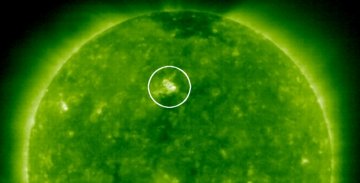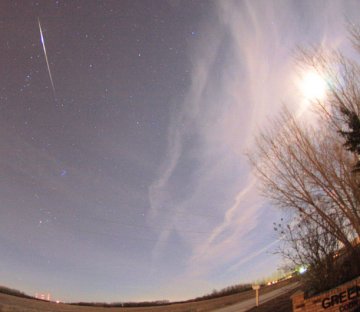| WAKE UP! Did you sleep through the auroras of October? Next time get a wake-up call: Spaceweather PHONE. | | | PHOENIX LOSES POWER: Mars lander Phoenix has lost power and is no longer communicating with Earth. The problem was not deepening cold at Phoenix's arctic landing site, but rather waning winter sunlight and a dust storm that dimmed the sun even more than expected. Phoenix's solar panels could not gather the light they needed to charge the lander's batteries. Mission planners always knew Phoenix would not survive the winter, so this comes as no surprise. Farewell Phoenix, and congratulations to the Phoenix team on a very successful mission. SOLAR CYCLE UPDATE: "Solar minimum is behind us," declares NASA sunspot forecaster David Hathaway. He bases the assertion on a flurry of new-cycle sunspots in October 2008. For the first time, active regions from new Solar Cycle 24 are outnumbering active regions from old Solar Cycle 23. Solar activity remains generally low, but the sun is showing signs of life. November is picking up where October left off with the formation of yet another new-cycle sunspot, provisionally numbered 1008. It appeared today at the location circled in this SOHO UV image of the sun: 
Inside that bright nest of magnetic loops, a dark sunspot is rapidly coelescing. Howard Eskildsen photographed it from his backyard observatory in Ocala, Florida. Readers, if you have a solar telescope, now is your chance to watch sunspot genesis in action. more images: from Stephen Ames of Hodgenville, Kentucky; from Adrian Guzman of San Jose, California; TAURID FIREBALLS: There's a bright Moon out tonight, but it's not putting a damper on the Taurid meteor shower. That's because Taurids tend to be fireballs: 
"I caught this very long and bright Taurid meteor on Nov. 8th," says Bob Johnson of Saskatoon, Saskatchewan."It really lit up the sky!" Earth is passing through a swarm of gritty debris from comet 2P/Encke and this is causing fireballs to shoot out of the constellation Taurus. They can appear at any time; Taurus rises in the east at sunset and stays up all night long. Some patience is required. You may have to stay outside an hour or more to see one, but one fireball is enough to make the wait worthwhile: sky map. UPDATE: "Around 8:26 p.m. EST on Nov. 9th, I saw several Taurid fireballs appear within one minute," reports Mark Balzer of Spiro, Oklahoma. "All were around mag. -4 to -6 and had that greenish 'Tarurid hue.' These were Taurids--from the horns, no doubt about it--and they were traveling together in a bunch. I believe they must have come from the same parent fragment. It was odd seeing five fireballs within one minute, then NO other meteors for 30 minutes." 2008 Taurid Fireball Gallery
[2005 Taurids: on Earth, on the Moon] | 
